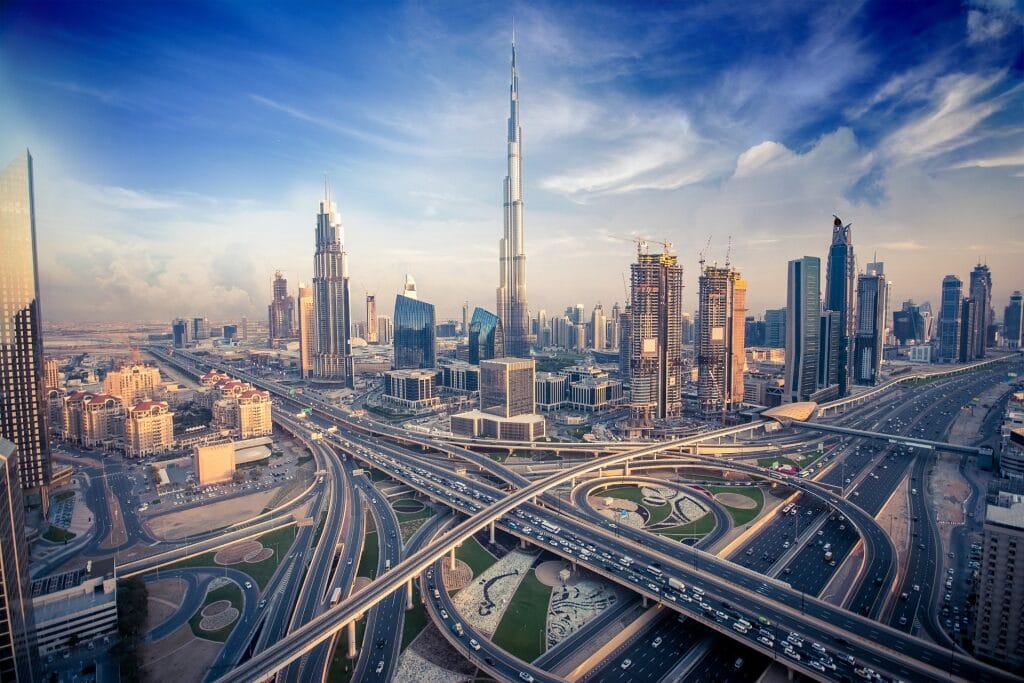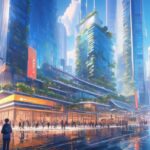Get ready for an eye-opening adventure into the future of cities! We’re about to explore some of the coolest, most cutting-edge cities on the planet – places that are like living laboratories for new ideas and technologies. From towering buildings that touch the sky to eco-friendly transportation systems, these cities are setting the pace for what the future holds. Join us as we uncover the secrets of urban innovation and discover how these cities are transforming the way we live, work, and play.
The Most Modern Cities in the World
Ever wonder what makes a city truly modern? It’s not just about towering skyscrapers and shiny buildings. It’s about blending cutting-edge technology with everyday life in a way that benefits everyone. Think super-efficient public transport, green spaces where you can actually breathe, and a constant buzz of new ideas. Let’s take a trip around the globe and explore some cities leading the way in urban innovation!
1. Tokyo: Where Ancient Traditions Meet the Future
Tokyo consistently tops the charts as one of the most modern cities, and it’s easy to see why. Imagine walking through neon-lit streets, passing by centuries-old temples, then hopping on a bullet train that whisks you away at unimaginable speeds—all in a day’s exploration! This city effortlessly blends the ancient with the ultra-modern. Tokyo’s dedication to making life easier is evident in its impeccably clean streets and a public transportation system that runs like clockwork. This seamless blend of tradition and innovation is what consistently places Tokyo among the most modern cities in the world.
2. Singapore: A Tiny Island with Big City Dreams
Don’t let its size fool you; Singapore is a powerhouse of urban planning. This island city-state is like a living laboratory for innovation, always experimenting with new ways to improve urban living. Education and technology are top priorities, attracting some of the brightest minds on the planet. But Singapore isn’t all work and no play. The city is bursting with lush green spaces, delicious food, and a vibrant cultural scene.
3. Helsinki: Putting People and Nature First
Nestled amidst stunning natural beauty, Helsinki offers a fresh perspective on what it means to be a modern city. This Finnish gem is all about sustainability and making life better for its residents. Imagine solar panels powering homes, electric buses gliding through the streets, and more green spaces than you can count—Helsinki proves that progress and nature can go hand-in-hand.
4. Seoul: A City that Never Sleeps (And Never Stops Innovating)
Seoul is a city that pulsates with energy. One moment you’re captivated by the beauty of ancient palaces, and the next, you’re immersed in a world of K-Pop and cutting-edge technology. Seoul is a global leader in digital innovation, with super-fast internet speeds and a tech-savvy population. But it’s not just about gadgets and gizmos—Seoul also boasts a rich cultural heritage, delicious street food, and a vibrant art scene.
What Is the Most Modernized City in the World?
So, we’ve been talking about cities changing and becoming more modern, but what about the most modern city? That’s a tough one, as different cities excel in different areas. But if we’re looking at overall innovation, efficiency, and quality of life, Singapore often claims the top spot.
Why is Singapore considered so modern? Well, they’ve really mastered the art of city planning. Imagine a city that’s super efficient, where transportation is a breeze, and everything seems to just work. Singapore pulls it off! Plus, they’re big on sustainability, constantly looking for ways to be eco-friendly and protect the environment.
Of course, we can’t talk about modern cities without mentioning Tokyo. This city is like a real-life version of a futuristic sci-fi movie! Tokyo is famous for its technological advancements, especially in areas like robotics and electronics. Additionally, their healthcare system is considered top-notch.
Now, you might be thinking, “What about all those towering skyscrapers? Don’t those scream ‘modern city’?” You’re not wrong! Many modern cities are known for their impressive skylines. It’s like they’re reaching for the stars with their buildings! But being modern isn’t just about looks; it’s also about how well a city functions and how it embraces new ideas.
Which City Is the Most Advanced in the World?
Choosing the absolute most advanced city is a bit like choosing the best ice cream flavor – it depends on what you value most! But just like some ice cream flavors are classics for a reason, some cities consistently top the “most advanced” lists.
So, what makes a city stand out as truly advanced?
- Seamless Transportation: Imagine zipping around the city with ease, thanks to a well-connected and efficient public transport system. No more traffic nightmares!
- Cutting-Edge Technology: Advanced cities are early adopters of the latest technologies, integrating them into everyday life to make things run smoother and more efficiently.
- Sustainability Smarts: Being environmentally conscious is a must for any forward-thinking city. Look for innovations in renewable energy, waste management, and green spaces.
- A High Quality of Life: Ultimately, a truly advanced city is one where residents enjoy a high quality of life, with access to excellent healthcare, education, cultural experiences, and a clean and safe environment.
With those factors in mind, cities like Tokyo, with its legendary public transport and tech scene, and Singapore, with its smart city initiatives and focus on sustainability, often top the list.
Which Current City Is No. 1 in the World?
Crowning one city as the absolute “best” is nearly impossible, as there are so many ways to measure success. However, some cities consistently rank high across multiple categories, making them strong contenders for the top spot. Here are a few that frequently earn top marks:
- Singapore: This island nation is practically synonymous with innovation and efficiency. Their Intelligent Transport System, which helps traffic flow smoothly, and their Smart Grid, which optimizes energy use, are just two examples of how Singapore is using technology to create a more livable and sustainable future.
- Tokyo: This vibrant metropolis seamlessly blends ancient traditions with futuristic technology. Tokyo is a global leader in robotics, electronics, and infrastructure.
- New York City: As a global center for finance, art, and culture, New York City is a melting pot of ideas and a driving force in global trends.
- London: Steeped in history but always evolving, London continues to be a global influencer. The city boasts incredible architecture, world-class museums, and a thriving cultural scene.
Rather than focusing on one “winner,” it’s more insightful to examine what these cities are doing well and how they’re tackling the challenges of the 21st century. Whether it’s embracing cutting-edge technology, honoring the past while stepping into the future, or using their global influence to drive progress, these cities are showing us that a brighter, more sustainable future for urban living is within reach.
What Is the Most Technologically Advanced City on Earth?
Choosing the absolute most technologically advanced city is like trying to pick the best flavor of ice cream – personal preferences abound! However, certain cities consistently stand out for their innovative use of technology, weaving it into the very fabric of how their city functions.
Here’s what to look for in a technologically advanced city:
- Lightning-Fast Internet: Fast, reliable, and accessible internet is the backbone of any tech-savvy city.
- AI Integration: Leading cities are using Artificial Intelligence not to replace humans, but to solve real-world problems and improve efficiency in areas like transportation and resource management.
- A Thriving Startup Scene: A city bursting with startups is a sure sign of a healthy and competitive tech environment.
So, which cities are leading the charge?
- Tokyo: From its mind-blowing robotics to its super-efficient transportation system, Tokyo consistently ranks high for its technological prowess.
- Seoul: This digitally connected metropolis boasts incredible internet speeds and a vibrant startup culture.
- Singapore: Singapore is the poster child for the “smart city” concept, using sensors, data analysis, and AI to optimize just about everything, from traffic flow to energy use.
- Jakarta: This rapidly growing metropolis is quickly becoming a tech hub for Southeast Asia, with a focus on mobile technology and e-commerce.
But why does being technologically advanced matter?
- Environmental Benefits: Smart cities can use technology to monitor and reduce their environmental impact, promoting sustainability and combating climate change.
- Increased Efficiency: From smart grids that optimize energy distribution to traffic management systems that reduce congestion, technology can make cities run smoother and more efficiently.
- Citizen Empowerment: Smart cities often empower their residents to participate in city life through apps and online platforms, fostering a sense of community and improving communication between citizens and local governments.
What Is the World’s Most Aesthetic City?
Beauty is subjective, and what one person finds breathtaking, another may find underwhelming. However, certain cities possess an undeniable allure, captivating visitors with their unique blend of architecture, cultural heritage, and natural beauty.
Here are a few cities renowned for their aesthetic appeal:
- Paris: Paris is often associated with romance and beauty. From the iconic Eiffel Tower to the charming cafes and picturesque streets, this city has a magical quality that’s hard to resist.
- Venice: Built on water, Venice is a city unlike any other. The canals, gondolas, and colorful buildings create a dreamlike atmosphere.
- Kyoto: Kyoto offers a glimpse into Japan’s rich history and culture. Ancient temples, serene shrines, and meticulously designed gardens make this city a feast for the eyes.
- Barcelona: This Spanish city pulsates with energy and a unique architectural style. The works of Antoni Gaudí, like the Sagrada Familia, add a touch of whimsy and grandeur.
- Istanbul: Where East meets West, Istanbul is a city of contrasts, with magnificent mosques, bustling markets, and stunning views of the Bosphorus Strait.
What Is the Most Stylish City in the World?
Some cities effortlessly exude style, influencing global fashion trends and attracting those with a keen eye for aesthetics. But what makes a city a true style icon? It’s a combination of factors, including:
- Influential Designers: Cities that are home to renowned fashion houses and designers often set the trends for the rest of the world.
- Unique Street Style: It’s not just about high fashion; the way locals express themselves through their clothing choices also contributes to a city’s overall stylish vibe.
- A Mix of High-End and Accessible Fashion: The most stylish cities offer a diverse range of shopping experiences, from luxury boutiques to vintage shops and independent designers.
Here are a few cities renowned for their style credentials:
- Paris: As the birthplace of haute couture and home to iconic fashion houses like Chanel, Dior, and Yves Saint Laurent, Paris is arguably the world’s fashion capital.
- Milan: This Italian city is synonymous with luxury fashion. Design powerhouses like Gucci, Prada, and Versace call Milan home.
- New York City: A melting pot of cultures and styles, New York City celebrates individuality and self-expression through fashion.
- London: From high-end department stores to independent boutiques, London offers a diverse fashion scene.
Which Is the Most Developed City in the World?
Defining the most developed city is incredibly complex, as “development” can be measured in many ways. However, we can look for cities that excel across multiple categories, including:
- Technological Advancement: Think smart cities that seamlessly integrate technology into everyday life, improving efficiency, sustainability, and quality of life.
- Environmental Sustainability: Truly developed cities prioritize the health of the planet, investing in renewable energy, green spaces, and sustainable infrastructure.
- Economic Prosperity: A strong and diverse economy provides opportunities for residents and attracts global talent.
- Cultural Vibrancy: A city rich in culture and art offers a high quality of life and attracts visitors from around the world.
- Social Well-being: The most developed cities prioritize the well-being of their residents, providing access to quality healthcare, education, and a safe and inclusive environment.
Rather than crowning one “winner,” it’s more insightful to look at how different cities are excelling in various areas:
- Cities That Feel Like the Future: Tokyo, for its seamless public transport and technological innovation, and Singapore, for its smart city initiatives, come to mind.
- Green Cities, Happy People: Cities like Helsinki and Copenhagen prioritize sustainability, with a focus on green spaces, renewable energy, and cycling infrastructure.
- Global Economic Powerhouses: London and New York City attract businesses and talent from around the world, driving innovation and economic growth.
- Cultural Hubs: Paris and Barcelona are renowned for their art, music, history, and overall cultural richness.
- High Quality of Life Leaders: Cities like Oslo and Zurich consistently rank high for their quality of life, thanks to their clean environments, safety, excellent healthcare systems, and work-life balance.
What Is the Most Perfectly Planned City in the World?
What makes a city “perfectly planned” is subjective and constantly evolving as our understanding of urban planning advances. However, we can look for cities that excel in areas like:
- Efficient Transportation: A well-designed public transportation system minimizes traffic congestion and makes it easy for residents to get around.
- Pedestrian-Friendly Design: Cities designed with pedestrians in mind are more enjoyable and often healthier, as they encourage walking and reduce pollution.
- Green Spaces: Integrating parks and green areas into urban areas is essential for sustainability, improving air quality, and enhancing the overall livability of a city.
- Adaptability: A truly well-planned city can adapt to changing needs and demographics, ensuring it remains livable and sustainable for generations to come.
Here are a few cities often praised for their urban planning:
- Seoul: Seoul has earned praise for its efficient public transport system, pedestrian-friendly design, and efforts to incorporate green spaces into its urban fabric.
- Chandigarh, India: Designed by the renowned architect Le Corbusier, Chandigarh is a prime example of modernist urban planning, with a grid system, wide boulevards, and an abundance of green spaces.
- Copenhagen, Denmark: Copenhagen is often lauded for its cycling infrastructure, which has created a quieter, cleaner, and more livable city.
It’s important to remember that “perfect” is elusive, and what works for one city might not work for another. Factors like culture, geography, and economic resources all play a role in shaping a city’s development.
Where Is the Most Futuristic City?
Some cities seem to exist on the cutting edge of innovation, embracing technology and sustainability in ways that feel ripped from the pages of a science fiction novel. Here’s what to look for in a truly futuristic city:
- Advanced Technology: Think self-driving cars, smart homes, and infrastructure that utilizes artificial intelligence to optimize efficiency and resource management.
- Sustainability at the Forefront: Futuristic cities understand the importance of environmental stewardship and prioritize renewable energy, green building practices, and minimizing their ecological footprint.
- Bold Architecture: From soaring skyscrapers to buildings that seem to defy gravity, futuristic cities often push the boundaries of architectural design.
Here are a few cities that embody a futuristic spirit:
- Dubai, UAE: Known for its awe-inspiring skyscrapers, man-made islands, and constant drive to push the boundaries of what’s possible, Dubai embodies a futuristic vision.
- Tokyo, Japan: With its cutting-edge robotics, super-efficient transportation system, and a tech scene that’s always ahead of the curve, Tokyo feels like a glimpse into the future.
- Helsinki, Finland: This city takes sustainability to the next level, earning high marks for its green spaces, clean energy use, and dedication to creating a high quality of life for its residents.
- Singapore: As a leader in smart city technology, Singapore uses data, sensors, and AI to optimize everything from traffic flow to resource management.
Which City Is a Modern City?
Defining a “modern city” can be subjective, as different cities embody modernity in diverse ways. However, common threads run through many of the world’s leading urban centers. Here are some key characteristics to consider:
- Advanced Infrastructure: Modern cities often boast efficient transportation systems, reliable internet access, and infrastructure designed to support a high quality of life.
- Technological Integration: From smart city initiatives to a thriving tech scene, modern cities embrace technology as a tool for progress and improvement.
- Sustainability Focus: Recognizing the importance of environmental responsibility, modern cities prioritize sustainable practices, such as renewable energy, green spaces, and efficient resource management.
- Cultural Vibrancy: Modern cities are often cultural melting pots, offering a rich tapestry of art, music, cuisine, and global influences.
- Constant Evolution: Perhaps the most defining characteristic of a modern city is its ability to adapt, evolve, and constantly seek new and innovative solutions to urban challenges.
Cities like Tokyo, Singapore, and London consistently earn top marks for their modern amenities, efficient infrastructure, and commitment to progress. Asian cities, in particular, have made significant strides in recent years, often prioritizing sustainability and technological innovation in their urban development. However, cities like New York, London, and Paris remain influential global hubs, constantly reinventing themselves and shaping trends in various fields.
As you can see, there’s no single definition of a “modern city.” It’s more about how a city combines technology, sustainability, design, and culture to create a thriving and livable environment for its residents.
Want to Learn More About How Modern Cities Are Shaping Our World?
- Discover the world’s most renowned waterways on our page dedicated to famous rivers, where you’ll find captivating stories and breathtaking images.
- Explore the capital city along which the Nile runs, unraveling its historical significance and modern vibrancy.
- For an unforgettable urban adventure, delve into the most famous cities in the US, where iconic landmarks and cultural treasures await.
The world’s cities are in a constant state of flux, always evolving and adapting to the challenges and opportunities of our ever-changing world. One thing’s for sure: exploring these urban landscapes and witnessing firsthand the innovation, creativity, and resilience of their residents is an endlessly fascinating journey!
- Sept 31 Myth: Unveiling Calendar Secrets - March 18, 2025
- How Long & Till December 18, 2025: Accurate Countdown Guide - March 18, 2025
- Discover Japanese Artists: A Complete History - March 18, 2025
















